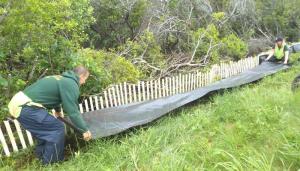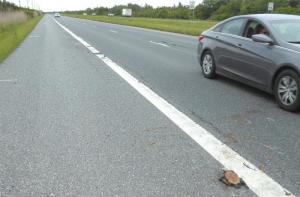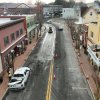For Rehoboth Bay's population of female terrapins, the bayside face of Delaware Seashore State Park's Atlantic Ocean dune is the perfect location to lay their eggs each spring.
Females like to lay their eggs in a sandy area that's wide open with some grass mixed in, said Chris Bennett, Seashore State Park environmental stewardship program manager. He said terrapin nests are about an inch and a half in diameter, and as far down as they can dig, which, said Bennett, is about six inches. Each female will lay about 20 eggs, he said.
"Even in the best places, most get dug up by predators," he said.
The hatchlings from nests that do survive the two-month incubation period will make their way to the protection of the bay's thick marsh grasses, said Bennett, until they're too big to be swallowed whole by a blue heron.
With the odds of survival already stacked against them, the bay's turtles face another challenge – they also have to play a real-life game of Frogger to get to the dunes.
The problem, said Bennett, is the turtles have to cross eight lanes of Coastal Highway traffic to make it safely from the bay to the dune and back.
That treacherous journey is why, since 2003 and with the help of other groups, the Delaware Department of Natural Resources and Environmental Control has overseen the annual installation of terrapin fencing along the eastern edge of Rehoboth Bay on Route 1 – from Key Box Road just south of Dewey past Old Inlet Bait and Tackle. There are also signs, sponsored by the Center for the Inland Bays and Conectiv, warning drivers of the turtles.
Bennett said typically, the turtles are in full egg-laying mode by June 1, but it can be a bit weather dependent. This year, May was so cold and rainy, it appears to have pushed them back a little bit, he said.
Bennett said the fencing program started after a concerned citizen contacted then-DNREC Secretary John Hughes about dozens of dead terrapins lining the side of the road.
Through the use of aerial photos, and then with in-person confirmation, Bennett said he was able to determine there's a sizeable amount of upland habitat suitable for females to lay their eggs on the west side of Route 1.
The installation of the terrapin fence is a tedious process. The fence is a combination of dune fencing cut in half that's then covered by silt fencing, which is needed, said Bennett, because the turtles were turning themselves sideways and pushing through the openings in the fence with their hind legs.
Dressed head to toe in foul-weather gear, Ashley Kroon, a natural resource planner for DNREC, and four members of the Delaware Veterans Conservation Corps were out May 30 replacing the fencing.
Kroon said they got a late start this year, but she's hoping the cool and rainy May has kept the turtles in the bay.
"I haven't seen any turtles hit yet," she said.
The four corps members, knee deep in roadside brush, including a hefty amount of poison ivy, were in good spirits as they moved at a turtle's pace down Coastal Highway replacing areas of protective fencing that had been destroyed over the past year by vehicles or the barrier island's unforgiving weather.
This was the second year for Mark Kammer, an Army veteran, and he was the team leader. The other three members included Navy veteran Glen Moore, Army veteran Andrew Hansen and Rhiannon Dillon, whose parents both served – mom in the Air Force, dad in the Air Guard.
Just like all military procedures, a plan was made and then executed. Kroon went ahead preparing the area by pulling out the old silt and dune fencing. Moore and Hansen followed, uncoiling and installing the dune fencing. A section was finished after Kammer and Dillon stapled the silt fence onto the dune fence.
"This is the second week, and as long as the weather cooperates it's not too bad," said Kammer. "At least the bugs aren't out. Last year the ticks were terrible. It's all to save the turtles."
Bennett said there isn't the funding to support full-fledged monitoring of the road, but every time someone from the stewardship program has to go to a meeting south of Dewey, they make note of dead turtles. He said, anecdotally, the program is working.
It used to be 70 or 80 a year, said Bennett. Now, he said, it's a dozen or so.
Bennett said he understands that in most cases there's little a driver can do. He doesn't encourage drivers to stop traffic to save a turtle. Instead, he said, notify the stewardship program where the turtle was hit to see if there's a hole in the fence that can be fixed.
Chris Flood has been working for the Cape Gazette since early 2014. He currently covers Rehoboth Beach and Henlopen Acres, but has also covered Dewey Beach and the state government. He covers environmental stories, business stories and random stories on subjects he finds interesting, and he also writes a column called Choppin’ Wood that runs every other week. He’s a graduate of the University of Maine and the Landing School of Boat Building & Design.

























































